
Elisa Weiss
RNutr, BSc Human Nutrition (Argentina)
Jump to:
- What is Vitamin B6?
- Vitamin B6 deficiency
- Different types of Vitamins B6
- Health Benefits
- Health Claims
- Best sources of Vitamin B6
- Daily requirements and intake
- How to take Vitamin B6
- Signs and symptoms of deficiency
- Risks and side effects
- Interactions - herbs and supplements
- Interactions - medication
- Summary
- Related Questions
As with all B vitamins, our body cannot produce vitamin B6, which means that we have to obtain it through diet or supplementation.
In developed countries there is a risk of mild deficiency, unless a person is suffering from certain conditions, which can then lead to more severe health issues.
Before we get into health benefits and signs and symptoms of deficiency, we’ll first cover the history and discovery of pyridoxine as vitamin B6.
What is Vitamin B6?
Vitamin B6 is a water-soluble vitamin, and one of the eight B vitamins.
This molecule is of great biological importance since its active coenzyme form, pyridoxal 5′-phosphate (PLP), participates in more than 100 biochemical reactions.[1]
Pyridoxine plays an active role in the metabolism of
Also, it influences brain development during pregnancy and childhood and is important for the immune system.[5,6]
History behind Vitamin B6
Vitamin B6 was a significant discovery by Paul György and his colleagues in 1934 during their experiments with riboflavin. They noted that rats already on a thiamine-only diet developed pellagra-like symptoms, even when given pure riboflavin.

The symptoms were only alleviated when the rats received supplements derived from a flavin-free baker’s yeast extract.
In contrast, rats given this extract but no riboflavin did not show pellagra-like symptoms. These results confirmed the presence of an ‘anti-pellagra’ factor that was biologically distinct from the newly discovered riboflavin.
Gyorgy named this new anti-pellagra factor B6 to distinguish it from other B vitamins.
In 1938 Samuel Lepkovsky isolated and crystallised vitamin B6, and a year later Folkers and Harris of Merck, simultaneously with Kuhn in Germany, determined the chemical structure of pyridoxine. In 1942, Esmond Snell developed a microbiological growth assay that led to the characterisation of pyridoxamine.
These discoveries were significant milestones and laid the foundation for future research exploring the benefits and applications of vitamin B6.[7,8]
Vitamin B6 deficiency
Vitamin B6 deficiency may be influenced by several conditions that disrupt the absorption and utilisation of the vitamin.
Who is most at risk of Vitamin B6 deficiency?
The following groups are at increased risk of vitamin B6 deficiency.
Individuals with kidney disease
Kidney disease can increase urinary excretion of vitamin B6, contributing to deficiency.[9]
People with compromised kidney function, including those with end-stage renal disease and chronic kidney failure, often have low levels of vitamin B6.
Additionally, patients undergoing renal dialysis or kidney transplantation may experience reduced levels of pyridoxine, possibly due to increased metabolic clearance of PLP.[10]
Individuals with digestive and autoimmune diseases
Certain autoimmune digestive disorders, such as coeliac disease, ulcerative colitis, and Crohn’s disease, can interfere with the absorption and utilisation of vitamin B6.[11]
RELATED — Coeliac Disease: Symptoms and Effects on our health and body
Autoimmune conditions like rheumatoid arthritis can increase the breakdown and utilisation of vitamin B6, resulting in reduced levels.[12]
Individuals with liver disease
Liver diseases can affect the storage and conversion of vitamin B6, resulting in an elevated risk of deficiency.[13]
Genetic diseases
Ageing population
Advancing age is associated with decreased absorption and utilisation of vitamin B6, which may increase the risk of deficiency.[16]
Alcohol consumption
Excessive alcohol consumption can alter the metabolism of vitamin B6 and increase excretion.
People with alcohol dependence commonly exhibit low plasma levels of pyridoxal 5′-phosphate (PLP), so vitamin B6 supplementation may benefit people with alcohol dependence.[17,18]
Smokers
Obesity
Obesity has been associated with decreased vitamin B6 levels, possibly due to impaired metabolism and elevated vitamin B6 requirements.[20]
Pregnant women
Pregnancy increases the demand for vitamin B6, and inadequate intake can lead to a deficiency.[21,22]
Different types of Vitamins B6
Vitamin B6 encompasses three primary forms
- pyridoxine hydrochloride
- pyridoxal hydrochloride
- pyridoxamine hydrochloride[5]
These compounds can be converted into the biologically active form of vitamin B6, pyridoxal 5′-phosphate (PLP), within the body.
PLP is a cofactor for many enzymes involved in amino acid metabolism, neurotransmitter synthesis, and glycogen breakdown.[23]
Vitamin B6 comprises six compounds, which are
- pyridoxal
- pyridoxine
- pyridoxamine
- their respective 5′ phosphates (see table below)[24]
The most common form in human tissue is the 5′-phosphate form of pyridoxal (PLP), found in muscle bound to phosphorylase.
Units of measurement | |||
Pyridoxine (PN) | 1g = 5.9 mmol | 1 mmol = 170 mg | Three naturally |
Pyridoxal (PL) | 1g = 6.0 mmol | 1 mmol = 167 mg | |
Pyridoxamine (PM) | 1g = 6.0 mmol | 1 mmol = 168 mg | |
Pyridoxal-5-phosphate (PLP) | 1g = 4.1 mmol | 1 mmol = 247 mg | Principal active form |
4-Pyridoxic acid (4-PA) | 1g = 5.5 mmol | 1 mmol = 183 mg | Principal excretory form |
Pyridoxine hydrochloride (PN.HCl) | 1g = 4.9 mmol | 1 mmol = 206 mg | Usual form of supplements |
Dietary supplements
Vitamin B6 is available in different forms as a supplement, including standalone supplements, multivitamins, and supplements that contain other B vitamins.
Pyridoxine is the most common form of vitamin B6 in supplements
Some supplements may also contain pyridoxal-5′-phosphate (PLP), the active form of vitamin B6.[1]
These supplements are available in oral capsules or tablets, including chewable and sublingual tablets, as well as in liquid form.
Although the body efficiently absorbs high pharmacological doses of vitamin B6, it excretes most excess vitamins through the urine.
Regarding FDA-approved drugs, two unique formulations contain pyridoxine or its analogues.[1]
One formulation combines multiple vitamins, including vitamin B6, to prevent deficiency in podiatric and adult patients receiving parenteral nutrition.[25]
Health benefits of Vitamin B6
Vitamin B6 has been associated with various health benefits supported by scientific research.
A rare seizure disorder
Sideroblastic anemia
This is a condition in which the body produces abnormal red blood cells that store iron. Taking vitamin B6 is effective in treating this type of hereditary anemia.[30,31]
Hyperhomocysteinemia
This condition is exhibited by high levels of homocysteine in the blood. Taking vitamin B6, usually with folic acid, effectively treats high levels of homocysteine in the blood.[32,33]
Health claims that still need more evidence and research
While scientific evidence supports certain health benefits of vitamin B6, more research is needed to establish a conclusive connection between various health claims.
One notable finding is its efficacy in treating nausea induced by pregnancy, although it is essential to note that a physician should supervise such use.
Cardiovascular disease
Scientific research on vitamin B6’s role in reducing cardiovascular disease risk through homocysteine reduction has yielded mixed results due to the inclusion of other supplements.[32,34]
While high homocysteine levels are associated with heart disease, vitamin B6 supplementation has not consistently decreased the risk.[35,36,37]
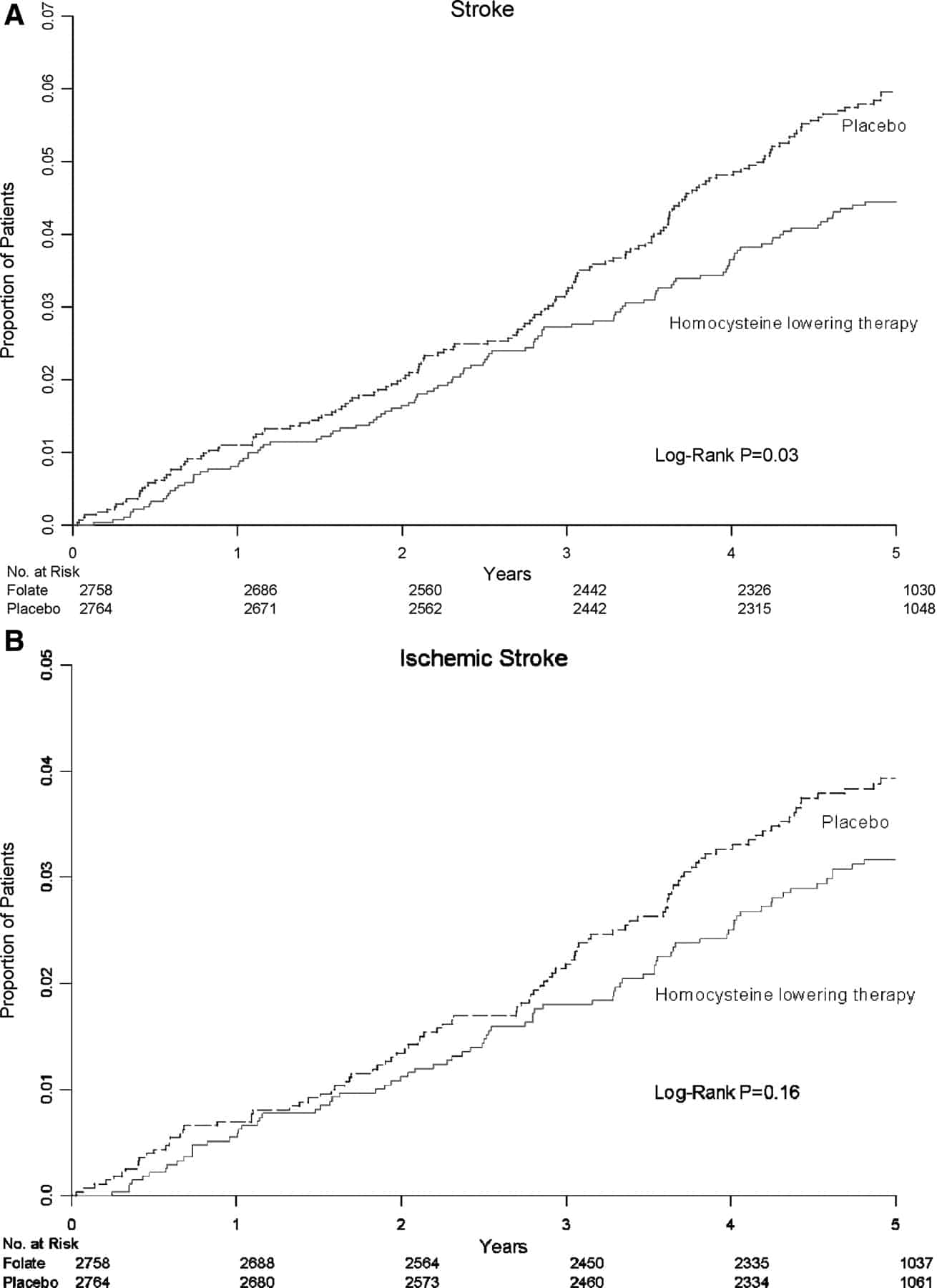
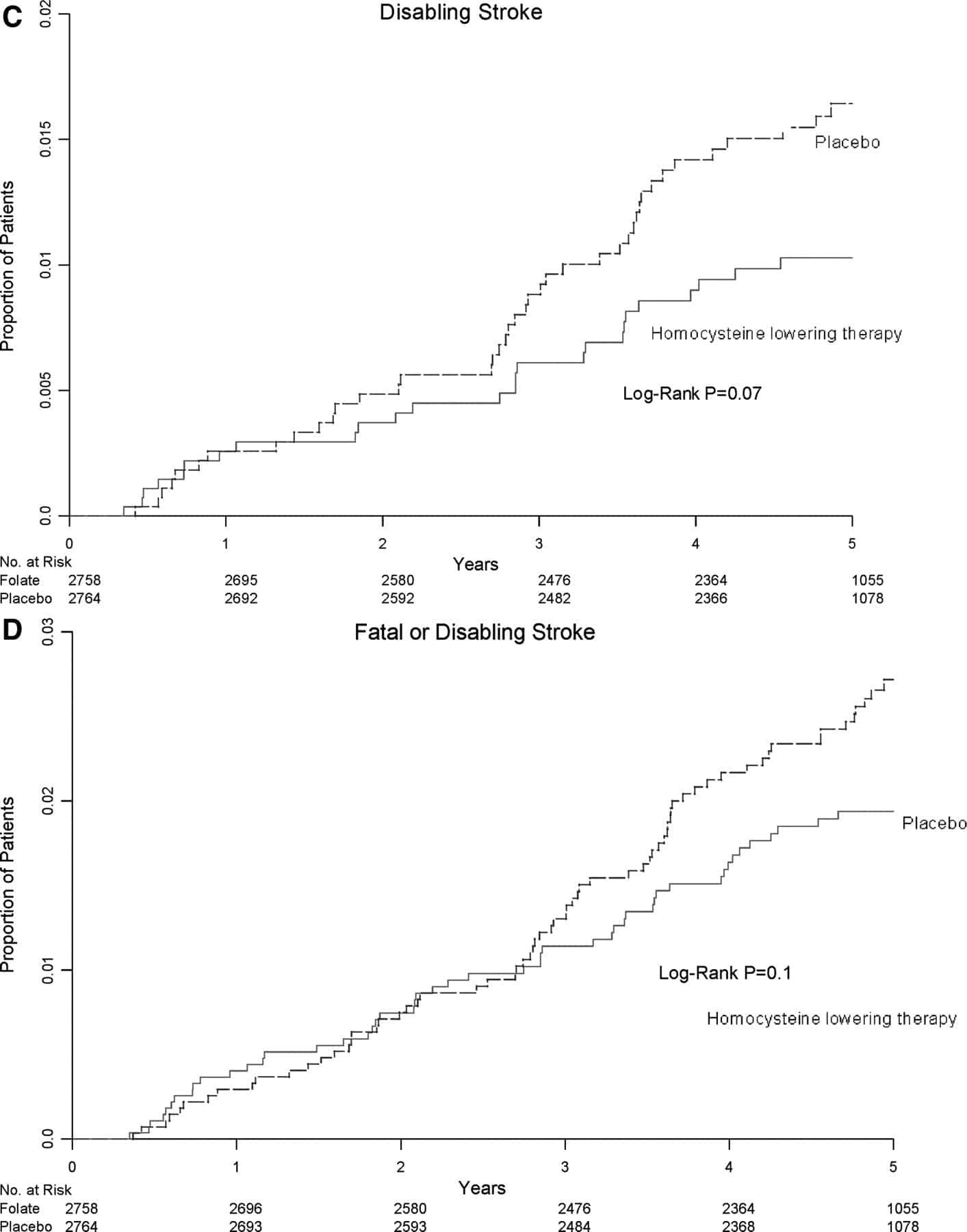
Cognitive function
It has been suggested that vitamin B6 indirectly supports cognitive function through its potential to lower homocysteine levels.
Boston Normative Study of Aging revealed a positive correlation between higher serum levels of vitamin B6 and better performance on memory tests in a group of 70 men aged 54 to 81.[38]
However, controlled trials supporting the efficacy of vitamin B6 supplementation in delaying cognitive decline are lacking and more research is needed.[39,40]
Cancer prevention
Epidemiological studies show that vitamin B6 is associated with a lower risk of certain types of cancer.[41]
Vitamin B6 may affect colorectal cancer risk through enzyme activity and its connection to inflammation.[42]
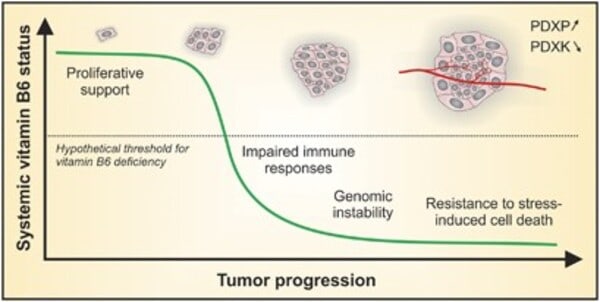
However, meta-analyses and prospective studies yield conflicting results, and more research is needed to understand the relationship between vitamin B6 and cancer risk.[43]
Nausea and vomiting in pregnancy
Nausea and vomiting, commonly known as “morning sickness”, are common symptoms during pregnancy and pyridoxine (vitamin B6) is often used as a first-line treatment, but its effectiveness varies among individuals.[44]
Vitamin B6 can help with nausea
Whilst vitamin B6 may help with nausea, its impact on reducing vomiting is limited.[45,46] Personalised guidance from healthcare professionals is advised, and further research is needed to optimise its use.[26]
Vitamin B6 and Premenstrual Syndrome (PMS)
Research on the use of vitamin B6 for relieving premenstrual syndrome (PMS) symptoms is limited but promising.
A meta-analysis suggested that vitamin B6 may be more effective than a placebo in reducing PMS symptoms, particularly mood-related symptoms.[47]
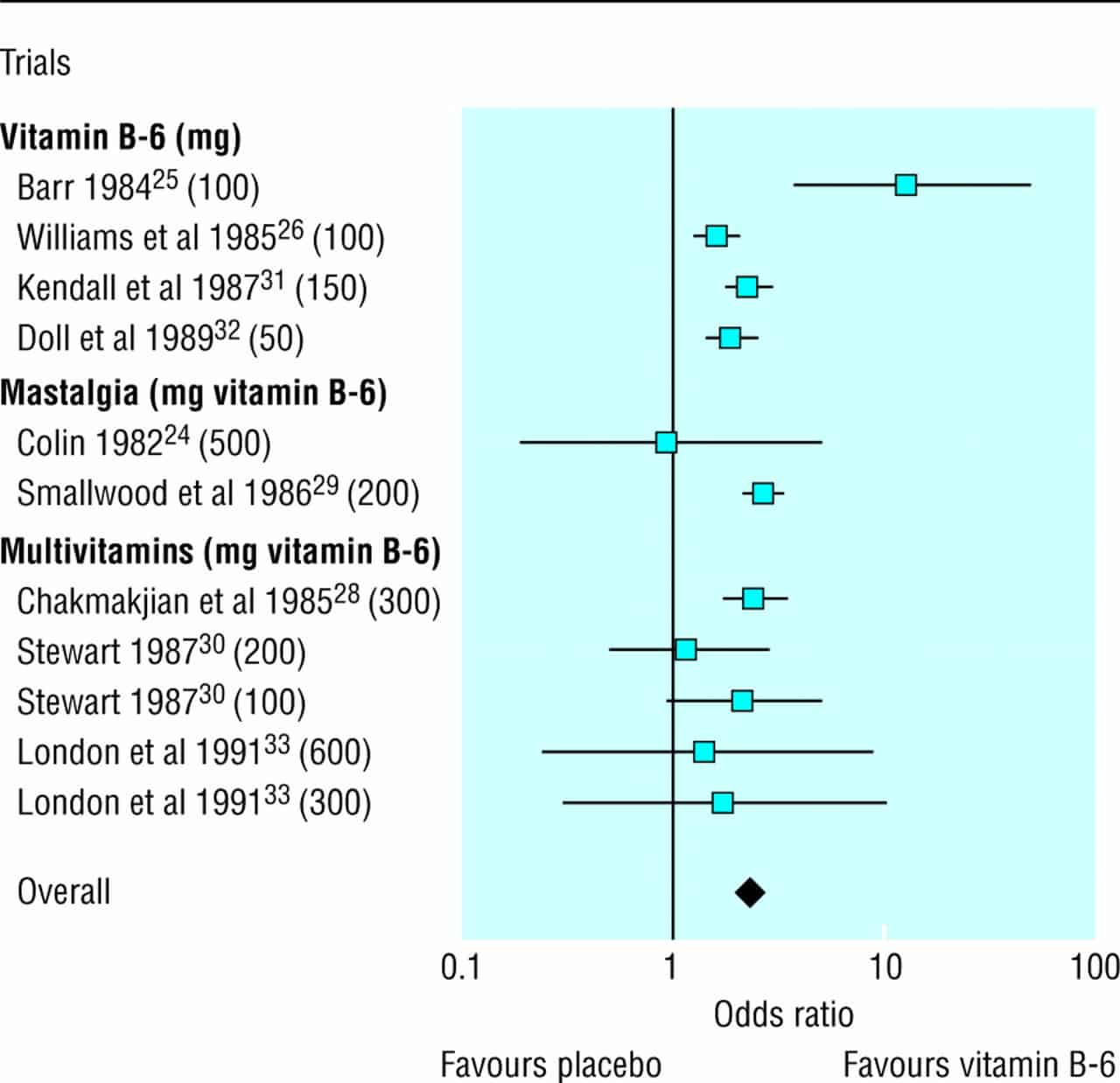
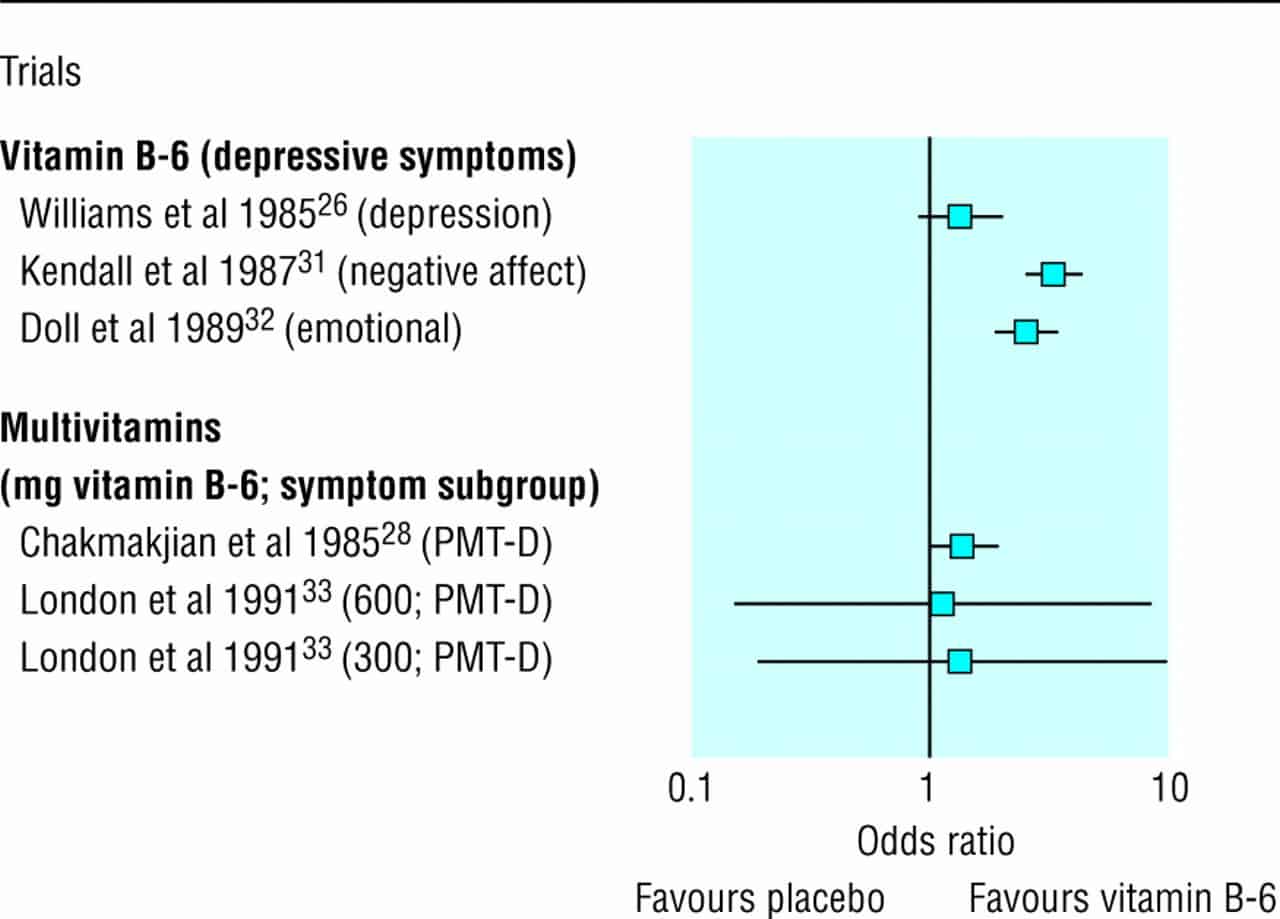
Combination therapy with vitamin B6 and magnesium also showed positive results.[48]
RELATED — Magnesium (for a great night of sleep)
Further investigation is necessary to establish safety, and efficacy, and provide informed recommendations for vitamin B6 supplementation in managing PMS symptoms.
Best sources of Vitamin B6
Vitamin B6 must be obtained from the diet because humans cannot synthesise it.
Vitamin B6 is present in a wide range of foods of both animal and vegetable origin, as shown in the table below.[12]
Food Source | Concentration (mg/100g) | Daily Value (DV) Men / Women |
Nut, pistachio | 1.5 mg | 115% |
Liver, chicken | 0.85 mg | 65% |
Yeast, dry powder | 0.82 mg | 63% |
Veal, steak, boneless | 0.79 mg | 61% |
Salmon | 0.75 mg | 58% |
Marmite | 0.57 mg | 44% |
Chicken, breast | 0.51 mg | 39% |
Breakfast cereal, mixed grain, barley & soy | 0.51 mg | 39% |
Nuts, chestnuts | 0.5 mg | 38% |
Chops, pork, loin, semi-trimmed | 0.33 mg | 25% |
Sweet potato, orange-unpeeled, fresh | 0.24 mg | 19% |
Bread, wholemeal | 0.25 mg | 19% |
Mushroom, Portobello | 0.22 mg | 17% |
Oats, wholegrain | 0.22 mg | 17% |
Beef, hindquarter skirt steak | 0.2 mg | 15% |
Bioavailability is generally in the region of 75% in a mixed diet.
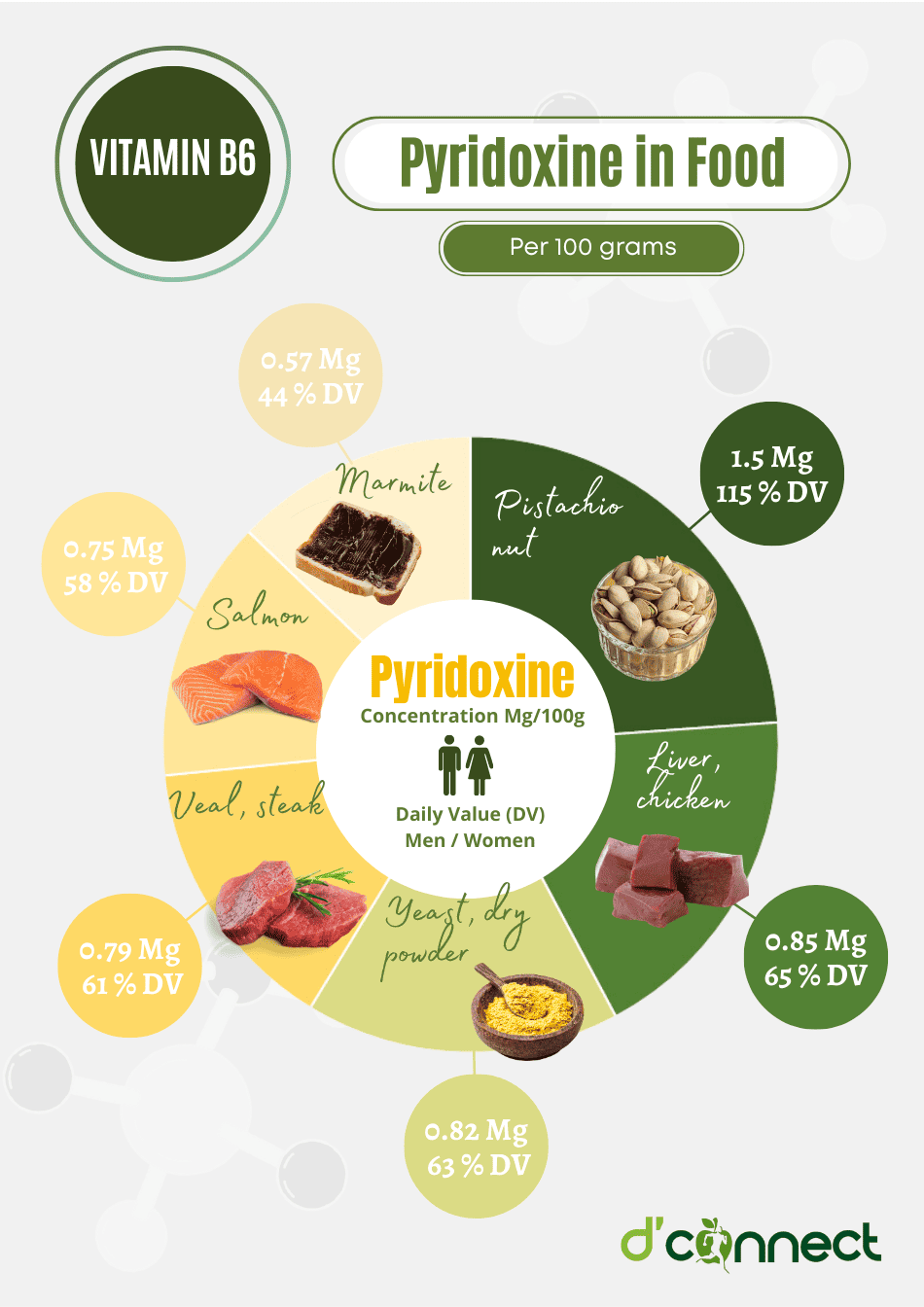
It has been proposed that vitamin B6 requirements may be increased at higher protein intake, although other studies have not shown this.[49]
Daily requirements and recommended intake
The Reference Daily Intake (RDI) for younger adults is 1.3 mg, while for men and women over 50, it increases to 1.7 mg and 1.5 mg, respectively.
For toddlers less than 12 months, we follow Adequate Intake (AI) guidelines.
Age | Male (AI) | Female (AI) |
0-6 months | 0.1 mg/day | 0.1 mg/day |
7-12 months | 0.3 mg/day | 0.3 mg/day |
Age | Male (RDI) | Female (RDI) |
1-3 years | 0.5 mg/day | 0.5 mg/day |
4-8 years | 0.6 mg/day | 0.6 mg/day |
9-13 years | 1.0 mg/day | 1.0 mg/day |
14-18 years | 1.3 mg/day | 1.2 mg/day |
19-30 years | 1.3 mg/day | 1.3 mg/day |
31-50 years | 1.3 mg/day | 1.3 mg/day |
51-70 years | 1.7 mg/day | 1.5 mg/day |
>70 years | 1.7 mg/day | 1.5 mg/day |
For pregnancy and lactation, the amount increases to 1.9 mg and 2.0 mg, respectively.
How to take Vitamin B6 as a supplement
Vitamin B6 can be administered orally or intravenously. Oral supplementation is the most common and easily accessible form, while the intravenous route is reserved for specific situations such as
- malabsorption syndromes
- anorexia
- patients dependent on parenteral nutrition
In addition, intramuscular and subcutaneous formulations of vitamin B6 are also available.[26]
Vitamin B6 can be taken at any time of the day, with or without food. However, taking it with food may help enhance absorption.
Common signs and symptoms of Vitamin B6 deficiency
Vitamin B6 deficiency can lead to various health problems due to its involvement in numerous metabolic processes.
A vitamin B6 deficiency most often occurs when other B vitamins are low, particularly vitamin B12 and folic acid.[17]
Mild vitamin B6 deficiency may be asymptomatic
A severe or prolonged deficiency may include dermatological issues, such as
- Seborrheic Dermatitis
- Glossitis
- Cheilosis
- Confusion
- Tingling and pain in hands and feet
- Seizures in adults
- Anemia
- Weakened Immune Function
- Tiredness and low energy
In infants, vitamin B6 deficiency causes irritability, abnormally acute hearing, and convulsive seizures.[27]
It is important to note that these symptoms do not definitively confirm a vitamin B6 deficiency, as they may also be associated with other medical conditions.
Therefore, a comprehensive evaluation by a health professional and laboratory tests are necessary for an accurate diagnosis and appropriate treatment.
Vitamin B6 risks and side effects
Contraindications to using vitamin B6 are limited to cases of hypervitaminosis B6 since excessive levels of the vitamin can lead to sensory neuropathy.
Also, people with hypersensitivity to pyridoxine should avoid its use.[50,51,52]
Reaching toxic levels of vitamin B6 from dietary sources alone is not plausible since the vitamin is water soluble. This means that any unused amounts will pass out of the body in urine.
Vitamin B6 supplements are generally safe when taken within the recommended dosage range. However, extremely high doses can cause neurological side effects.
Pyridoxine (vitamin B6) toxicity can occur with ingesting megadoses, high doses exceeding 500 mg daily.[51]
Excessive intake of vitamin B6 can cause adverse effects, including
- lack of muscle control or coordination of voluntary movements (ataxia)
- painful and disfiguring skin lesions
- heartburn
- nausea
- sensitivity to sunlight (photosensitivity)
- numbness
- decreased ability to perceive pain or extreme temperatures[52]
Paradoxically, the symptoms associated with vitamin B6 toxicity are similar to those of vitamin B6 deficiency.[52]
Treatment of vitamin B6 toxicity consists of discontinuing vitamin B6 supplementation. However, recovery may be slow and incomplete for some patients.[51,53]
Possible interactions with herbs and supplements
Vitamin B6 has the potential to interact with specific herbs and supplements, affecting their efficacy and side effects. Also, it’s important to note that vitamin B6 may have a blood pressure-lowering effect.[54]
When taken along with other supplements that also lower blood pressure, it can cause blood pressure levels to drop too much.
Such supplements include
- casein peptides
- L-arginine
- nettle
- niacin[55,56,57]
RELATED — Vitamin B3 (Niacin)
Careful consideration and medical supervision are recommended when combining vitamin B6 with these herbs and supplements to avoid adverse effects.
Possible interactions with medications
Vitamin B6 may interact with certain medications, such as antibiotics, antiepileptic drugs, and chemotherapy.
Long-term use of antiepileptics can reduce vitamin B6 levels over time, leading to a deficiency.[54]
Possible drug interactions include:
- Altretamine. Taking vitamin B-6 with this chemotherapy drug might reduce its effectiveness, especially when combined with cisplatin[55]
- Anticonvulsants. Taking vitamin B-6 with fosphenytoin or phenytoin might decrease the drug’s duration and intensity.[51]
- Some antiepileptic drugs, such as valproic acid, carbamazepine, and phenytoin, can reduce the levels of vitamin B6 in the body, which is associated with hyperhomocysteinemia.[27]
- Levodopa. Avoid taking vitamin B-6 with this drug used to treat Parkinson’s disease. Vitamin B-6 might reduce the drug’s effectiveness[56]
It is advisable to consult a healthcare professional before combining vitamin B6 with any prescription medications.
Summary
It’s best to obtain vitamin B6 through a balanced diet.
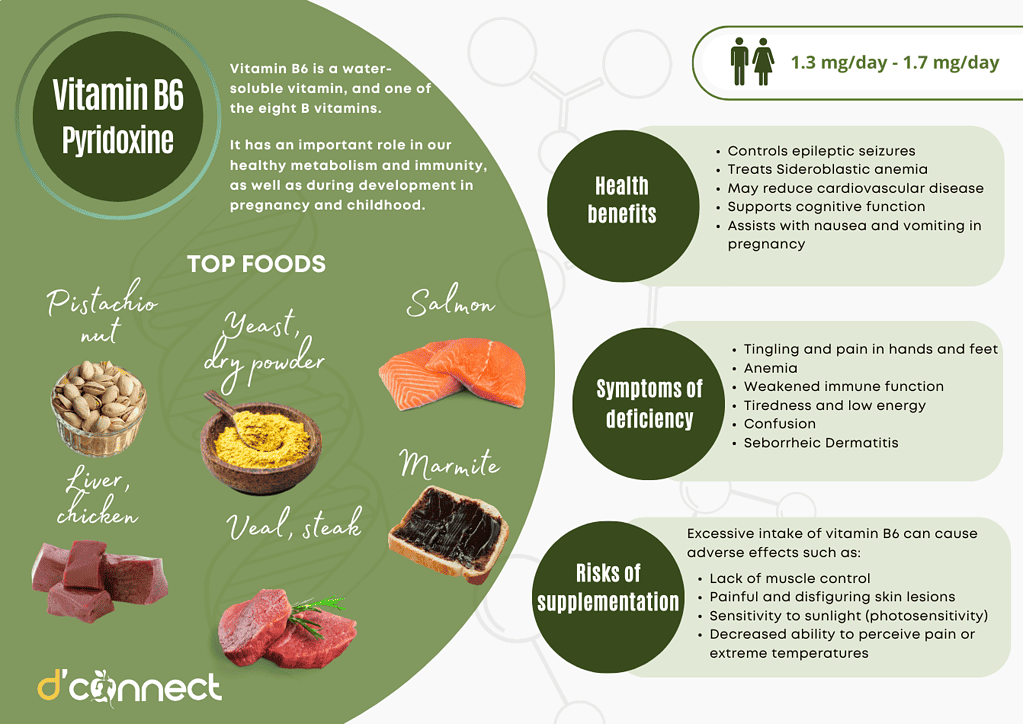
Key Takeaway — In this illustration we have outlined the most important information that you should know about Pyridoxine (vitamin B6).
Related Questions
1. Why is magnesium typically combined with B6?
Magnesium and vitamin B6 are often combined in supplements because they work synergistically to support various physiological processes.
Magnesium helps activate vitamin B6 into its active form, pyridoxal 5′-phosphate (PLP), effectively fulfilling its bodily functions.
2. Does vitamin B6 lower homocysteine?
Vitamin B6, B12, and folate are crucial in homocysteine metabolism.
Vitamin B6 alone may have varying effects on homocysteine levels, depending on factors such as diet and metabolism.[58]
3. Does vitamin B6 raise progesterone?
Limited evidence suggests that vitamin B6 supplementation may modestly increase progesterone levels.[59] However, further research is needed for a conclusive link.
4. Can vitamin B6 cause migraines?
Very high doses of vitamin B6 supplements have been associated with a rare side effect called vitamin B6-induced neuropathy, which can cause neurological symptoms, including headaches.[51,53]
It is important to adhere to the recommended dosage range and consult a healthcare professional if experiencing any adverse effects.
If you are interested in learning more about other B vitamins, we suggest browsing Connecting you with Food.
Elisa Weiss is a New Zealand Registered Nutritionist specialising in obesity, type 2 diabetes and digestive disorders. She has worked in community settings and private practice, focusing on holistic approaches to improve people’s health and well-being.
Elisa has a background in research, education and food science. Elisa is certified as a Neuro-Linguistic Programming (NLP) practitioner and has completed undergraduate and graduate studies in nutrition and dietetics, diabetes management and Ayurvedic medicine. She is currently doing a postgraduate diploma in Biomedical Sciences. She works in private practice using a no-diet and evidence-based approach.
Elisa is also actively involved in volunteer and professional development activities. You will find her doing outdoor activities or experimenting in the kitchen with different ferments when she is not working or studying.
References
(1) Abosamak NR, Gupta V. Vitamin B6 (Pyridoxine). Vitamins in the Prevention of Human Diseases [Internet]. 2023 Feb 27 [cited 2023 Jun 23];75–89. Available from: https://www.ncbi.nlm.nih.gov/books/NBK557436/
(2) Vitamin B6 in Health and Disease – PMC [Internet]. [cited 2023 Jun 23]. Available from: https://www.ncbi.nlm.nih.gov/pmc/articles/PMC8467949/
(3) Mooney S, Leuendorf JE, Hendrickson C, Hellmann H. Vitamin B6: A Long Known Compound of Surprising Complexity. Molecules 2009, Vol 14, Pages 329-351 [Internet]. 2009 Jan 12 [cited 2023 Jun 23];14(1):329–51.
(4) Molecules | Free Full-Text | Vitamin B6: A Long Known Compound of Surprising Complexity [Internet]. [cited 2023 Jun 23]. Available from: https://www.mdpi.com/1420-3049/14/1/329
(5) Salam RA, Zuberi NF, Bhutta ZA. Pyridoxine (vitamin B6) supplementation during pregnancy or labour for maternal and neonatal outcomes. Cochrane Database Syst Rev [Internet]. 2015 Jun 3 [cited 2023 Jun 23];2015(6). Available from: /pmc/articles/PMC10082995/
(6) Ciapaite J, Albersen M, Savelberg SMC, Bosma M, Tessadori F, Gerrits J, et al. Pyridox(am) in 5′-phosphate oxidase (PNPO) deficiency in zebrafish results in fatal seizures and metabolic aberrations. Biochimica et Biophysica Acta (BBA) – Molecular Basis of Disease. 2020 Mar 1;1866(3):165607.
(7) Rosenberg IH. A History of the Isolation and Identification of Vitamin B6. Ann Nutr Metab [Internet]. 2012 Nov 1 [cited 2023 Jun 23];61(3):236–8. Available from: https://dx.doi.org/10.1159/000343113
(8) GYöRGY P. The History of Vitamin B6. Am J Clin Nutr. 1956 Aug 1;4(4):313–7.
(9) Brown MJ, Ameer MA, Beier K. Vitamin B6 Deficiency. StatPearls [Internet]. 2022 Jul 18 [cited 2023 Jun 23]; Available from: https://www.ncbi.nlm.nih.gov/books/NBK470579/
(10) Metabolism of vitamin B6 and its requirement in chronic renal failure – PubMed [Internet]. [cited 2023 Jun 23]. Available from: https://pubmed.ncbi.nlm.nih.gov/9350682/
(11) Merrill AH, Henderson JM. Diseases Associated with Defects in Vitamin B6 Metabolism or Utilization. https://doi.org/101146/annurev.nu07070187001033 [Internet]. 2003 Nov 28 [cited 2023 Jun 23]; 7:137–56. Available from: https://www.annualreviews.org/doi/abs/10.1146/annurev.nu.07.070187.001033
(12) Vitamin B6 – Health Professional Fact Sheet [Internet]. [cited 2023 Jun 23]. Available from: https://ods.od.nih.gov/factsheets/VitaminB6-HealthProfessional/
(13) Licata A, Zerbo M, Como S, Cammilleri M, Soresi M, Montalto G, et al. The Role of Vitamin Deficiency in Liver Disease: To Supplement or Not Supplement? Nutrients 2021, Vol 13, Page 4014 [Internet]. 2021 Nov 10 [cited 2023 Jun 23];13(11):4014. Available from: https://www.mdpi.com/2072-6643/13/11/4014/htm
(14) Scully C. Metabolic disorders. Scully’s Medical Problems in Dentistry [Internet]. 2014 Jan 1 [cited 2023 Jun 23];594–606. Available from: https://linkinghub.elsevier.com/retrieve/pii/B9780702054013000230
(15) Sacharow SJ, Picker JD, Levy HL. Homocystinuria Caused by Cystathionine Beta-Synthase Deficiency. GeneReviews® [Internet]. 2017 May 18 [cited 2023 Jun 23]; Available from: https://www.ncbi.nlm.nih.gov/books/NBK1524/
(16) Kjeldby IK, Fosnes GS, Ligaarden SC, Farup PG. Vitamin B6 deficiency and diseases in elderly people – a study in nursing homes. BMC Geriatr [Internet]. 2013 [cited 2023 Jun 23];13(1):13. Available from: /pmc/articles/PMC3579689/
(17) Riordan HD, Mikirova N, Taylor PR, Feldkamp CA, Casciari JJ, Riordan HD, et al. The Effects of a Primary Nutritional Deficiency (Vitamin B study). Food Nutr Sci [Internet]. 2012 Sep 11 [cited 2023 Jun 23];3(9):1238–44. Available from: http://www.scirp.org/Html/8-2700481_22300.htm
(18) Uździcki AW, Zych A, Świerad BA, Wawrzynowicz-Syczewska M. The role of vitamin and microelement supplementation in the treatment of ethanol-induced liver disease. Prz Gastroenterol [Internet]. 2022 [cited 2023 Jun 23];17(4):253. Available from: /pmc/articles/PMC9743330/
(19) Hiperhomocysteinemia in active and passive smokers and the levels of folate and vitamin B6 in plasma – PubMed [Internet]. [cited 2023 Jun 23]. Available from:https://pubmed.ncbi.nlm.nih.gov/19189529/
(20) Haidari F, Mohammadshahi M, Zarei M, Haghighizadeh MH, Mirzaee F. The Effect of Pyridoxine Hydrochloride Supplementation on Leptin, Adiponectin, Glycemic Indices, and Anthropometric Indices in Obese and Overweight Women. Clin Nutr Res [Internet]. 2021 [cited 2023 Jun 23];10(3):230. Available from: /pmc/articles/PMC8331291/
(21) Nutrient Reference Values for Australia and New Zealand Including Recommended Dietary Intakes | NHMRC [Internet]. [cited 2023 Jun 23].
(22) Bertuccio MP, Currò M, Caccamo D, Ientile R. Dietary Intake and Genetic Background Influence Vitamin Needs during Pregnancy. Healthcare [Internet]. 2022 May 1 [cited 2023 Jun 23];10(5). Available from: /pmc/articles/PMC9141544/
(23) Parra M, Stahl S, Hellmann H. Vitamin B6 and Its Role in Cell Metabolism and Physiology. Cells [Internet]. 2018 Jul 22 [cited 2023 Jun 23];7(7). Available from: /pmc/articles/PMC6071262/
(24) Snell EE. Chemical Structure about Biological Activities of Vitamin B6. Vitam Horm. 1958 Jan 1;16(C):77–125.
(25) Wibowo N, Purwosunu Y, Sekizawa A, Farina A, Tambunan V, Bardosono S. Vitamin B₆ supplementation in pregnant women with nausea and vomiting. Int J Gynaecol Obstet [Internet]. 2012 [cited 2023 Jun 23];116(3):206–10. Available from: https://pubmed.ncbi.nlm.nih.gov/22189065/
(26) Matthews A, Haas DM, O’Mathúna DP, Dowswell T, Doyle M. Interventions for nausea and vomiting in early pregnancy. Cochrane Database Syst Rev [Internet]. 2014 Mar 21 [cited 2023 Jun 23];2014(3). Available from: https://pubmed.ncbi.nlm.nih.gov/24659261/
(27) Clayton PT. B6-responsive disorders: a model of vitamin dependency. J Inherit Metab Dis [Internet]. 2006 Apr [cited 2023 Jun 23];29(2–3):317–26. Available from: https://pubmed.ncbi.nlm.nih.gov/16763894/
(28) Vitamin B6 Deficiency and Dependency – Nutritional Disorders – MSD Manual Professional Edition [Internet]. [cited 2023 Jun 23]. Available from: https://www.msdmanuals.com/en-nz/professional/nutritional-disorders/vitamin-deficiency,-dependency,-and-toxicity/vitamin-b6-deficiency-and-dependency
(29) Johnstone DL, Al-Shekaili HH, Tarailo-Graovac M, Wolf NI, Ivy AS, Demarest S, et al. PLPHP deficiency: clinical, genetic, biochemical, and mechanistic insights. Brain [Internet]. 2019 Mar 1 [cited 2023 Jun 23];142(3):542–59. Available from: https://dx.doi.org/10.1093/brain/awy346
(30) Baumann Kreuziger LM, Wolanskyj AP, Hanson CA, Steensma DP. Lack of efficacy of pyridoxine (vitamin B6) treatment in acquired idiopathic sideroblastic anaemia, including refractory anaemia with ring sideroblasts. Eur J Haematol [Internet]. 2011 Jun [cited 2023 Jun 23];86(6):512–6. Available from: https://pubmed.ncbi.nlm.nih.gov/21388451/
(31) Heller T, Höchstetter V, Basler M, Borck V. [Vitamin B6-sensitive hereditary sideroblastic anemia]. Dtsch Med Wochenschr [Internet]. 2004 Jan 23 [cited 2023 Jun 23];129(4):141–4. Available from: https://pubmed.ncbi.nlm.nih.gov/14724775/
(32) Miodownik C, Lerner V, Vishne T, Sela BA, Levine J. High-dose vitamin B6 decreases homocysteine serum levels in patients with schizophrenia and schizoaffective disorders: a preliminary study. Clin Neuropharmacol [Internet]. 2007 Jan [cited 2023 Jun 23];30(1):13–7. Available from: https://pubmed.ncbi.nlm.nih.gov/17272965/
(33) Kaye AD, Jeha GM, Pham AD, Fuller MC, Lerner ZI, Sibley GT, et al. Folic Acid Supplementation in Patients with Elevated Homocysteine Levels. Adv Ther [Internet]. 2020 Oct 1 [cited 2023 Jun 23];37(10):4149. Available from: /pmc/articles/PMC7497502/
(34) Albert CM, Cook NR, Gaziano JM, Zaharris E, MacFadyen J, Danielson E, et al. Effect of folic acid and B vitamins on risk of cardiovascular events and total mortality among women at high risk for cardiovascular disease: a randomized trial. JAMA [Internet]. 2008 May 7 [cited 2023 Jun 23];299(17):2027–36. Available from: https://pubmed.ncbi.nlm.nih.gov/18460663/
(35) Saposnik G, Ray JG, Sheridan P, McQueen M, Lonn E. Homocysteine-Lowering Therapy and Stroke Risk, Severity, and Disability. Stroke [Internet]. 2009 Apr 1 [cited 2023 Jun 23];40(4):1365–72. Available from: https://www.ahajournals.org/doi/abs/10.1161/STROKEAHA.108.529503
(36) Shah AK, Dhalla NS. Effectiveness of Some Vitamins in the Prevention of Cardiovascular Disease: A Narrative Review. Front Physiol [Internet]. 2021 Oct 8 [cited 2023 Jun 23];12:729255. Available from: /pmc/articles/PMC8531219/
(37) Haslam A, Prasad V. Multivitamins do not reduce cardiovascular disease and mortality and should not be taken for this purpose: How do we know that? Circ Cardiovasc Qual Outcomes [Internet]. 2018 Jul 1 [cited 2023 Jun 23];11(7):4886. Available from: https://www.ahajournals.org/doi/abs/10.1161/circoutcomes.118.004886
(38) Riggs KM, Spiro A, Tucker K, Rush D. Relations of vitamin B-12, vitamin B-6, folate, and homocysteine to cognitive performance in the Normative Aging Study. Am J Clin Nutr. 1996 Mar 1;63(3):306–14.
(39) Balk EM, Raman G, Tatsioni A, Chung M, Lau J, Rosenberg IH. Vitamin B6, B12, and Folic Acid Supplementation and Cognitive Function: A Systematic Review of Randomized Trials. Arch Intern Med [Internet]. 2007 Jan 8 [cited 2023 Jun 23];167(1):21–30. Available from: https://jamanetwork.com/journals/jamainternalmedicine/fullarticle/411489
(40) Malouf R, Grimley Evans J. The effect of vitamin B6 on cognition. Cochrane Database Syst Rev [Internet]. 2003 Oct 20 [cited 2023 Jun 23];(4). Available from: https://pubmed.ncbi.nlm.nih.gov/14584010/
(41) Matsuo T, Sadzuka Y. In Vitro Anticancer Activities of B6 Vitamers: A Mini-review. Anticancer Res [Internet]. 2019 Jul 1 [cited 2023 Jun 23];39(7):3429–32. Available from: https://ar.iiarjournals.org/content/39/7/3429
(42) Larsson SC, Orsini N, Wolk A. Vitamin B6 and Risk of Colorectal Cancer: A Meta-analysis of Prospective Studies. JAMA [Internet]. 2010 Mar 17 [cited 2023 Jun 23];303(11):1077–83. Available from: https://jamanetwork.com/journals/jama/fullarticle/185551
(43) Zhang XH, Ma J, Smith-Warner SA, Lee JE, Giovannucci E. Vitamin B6 and colorectal cancer: Current evidence and future directions. World Journal of Gastroenterology : WJG [Internet]. 2013 Feb 2 [cited 2023 Jun 23];19(7):1005. Available from: /pmc/articles/PMC3581987/
(44) Devane D. Interventions for nausea and vomiting in early pregnancy. Practising Midwife [Internet]. 2010 Dec [cited 2023 Jun 23];13(11):38–9. Available from: https://www.cochranelibrary.com/cdsr/doi/10.1002/14651858.CD007575.pub2/full
(45) Ensiyeh J, Sakineh MAC. Comparing ginger and vitamin B6 for the treatment of nausea and vomiting in pregnancy: a randomised controlled trial. Midwifery. 2009 Dec;25(6):649–53.
(46) Vitamin B6 is effective therapy for nausea and vomiting of pregnancy: a randomized, double-blind placebo-controlled study – PubMed [Internet]. [cited 2023 Jun 23]. Available from: https://pubmed.ncbi.nlm.nih.gov/2047064/
(47) Wyatt KM, Dimmock PW, Jones PW, O’brien PMS. Efficacy of vitamin B-6 in the treatment of premenstrual syndrome:systematic review. BMJ [Internet]. 1999 May 22 [cited 2023 Jun 23];318(7195):1375–81. Available from: https://www.bmj.com/content/318/7195/1375
(48) De Souza MC, Walker AF, Robinson PA, Bolland K. A synergistic effect of a daily supplement for 1 month of 200 mg magnesium plus 50 mg vitamin B6 for the relief of anxiety-related premenstrual symptoms: a randomized, double-blind, crossover study. J Womens Health Gend Based Med [Internet]. 2000 Mar [cited 2023 Jun 23];9(2):131–9. Available from: https://pubmed.ncbi.nlm.nih.gov/10746516/
(49) Pannemans DLE, Van den Berg H, Westerterp KR. The Influence of Protein Intake on Vitamin B-6 Metabolism Differs in Young and Elderly Humans. J Nutr. 1994 Aug 1;124(8):1207–14.
(50) Bahadar H. Pyridoxine. Reference Module in Biomedical Sciences [Internet]. 2022 Jan 1 [cited 2023 Jun 23]; Available from: https://linkinghub.elsevier.com/retrieve/pii/B9780128243152001196
(51) Hemminger A, Wills BK. Vitamin B6 Toxicity. StatPearls [Internet]. 2023 Feb 7 [cited 2023 Jun 23]; Available from: https://www.ncbi.nlm.nih.gov/books/NBK554500/
(52) Vrolijk MF, Opperhuizen A, Jansen EHJM, Hageman GJ, Bast A, Haenen GRMM. The vitamin B6 paradox: Supplementation with high concentrations of pyridoxine leads to decreased vitamin B6 function. Toxicology in Vitro. 2017 Oct 1;44:206–12.
(53) Hadtstein F, Vrolijk M. Vitamin B-6-Induced Neuropathy: Exploring the Mechanisms of Pyridoxine Toxicity. Adv Nutr [Internet]. 2021 Sep 1 [cited 2023 Jun 23];12(5):1911–29. Available from: https://pubmed.ncbi.nlm.nih.gov/33912895/
(54) Lal KJ, Dakshinamurti K, Thliveris J. The effect of vitamin B6 on the systolic blood pressure of rats in various animal models of hypertension. J Hypertens [Internet]. 1996 [cited 2023 Jun 23];14(3):355–63. Available from: https://pubmed.ncbi.nlm.nih.gov/8723990/
(55) Szefler B, Czeleń P, Krawczyk P. The Affinity of Carboplatin to B-Vitamins and Nucleobases. Int J Mol Sci [Internet]. 2021 Apr 1 [cited 2023 Jun 23];22(7). Available from: /pmc/articles/PMC8037198/
(56) Klawans HL. Effect of vitamin B6 on levodopa-induced changes in spinal fluid homovanillic acid. J Neurol Sci. 1971 Dec 1;14(4):421–6.
(57) Noah L, Dye L, Bois De Fer B, Mazur A, Pickering G, Pouteau E. Effect of magnesium and vitamin B6 supplementation on mental health and quality of life in stressed healthy adults: Post‐hoc analysis of a randomised controlled trial. Stress and Health [Internet]. 2021 Dec 1 [cited 2023 Jun 23];37(5):1000. Available from: /pmc/articles/PMC9292249/
(58) Fratoni V, Brandi ML. B Vitamins, Homocysteine and Bone Health. Nutrients [Internet]. 2015 Mar 30 [cited 2023 Jun 23];7(4):2176. Available from: /pmc/articles/PMC4425139/
(59) Zhao Y, Hu S, Zhai W, Wang M, Ran L. Clinical Study of Progesterone Combined with Vitamin B6 in the Treatment of Amenorrhea Endocrine Disorders Caused by Antipsychotics. Comput Math Methods Med. 2022;2022.






